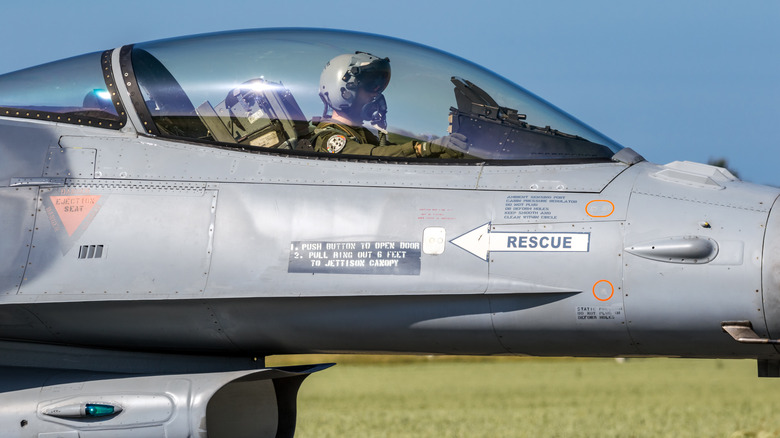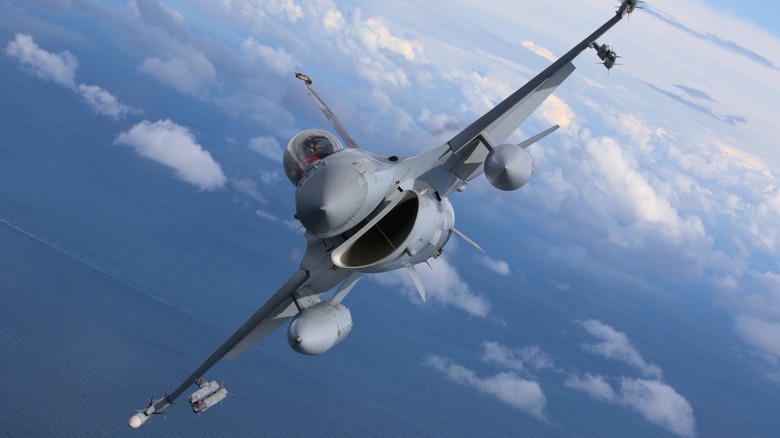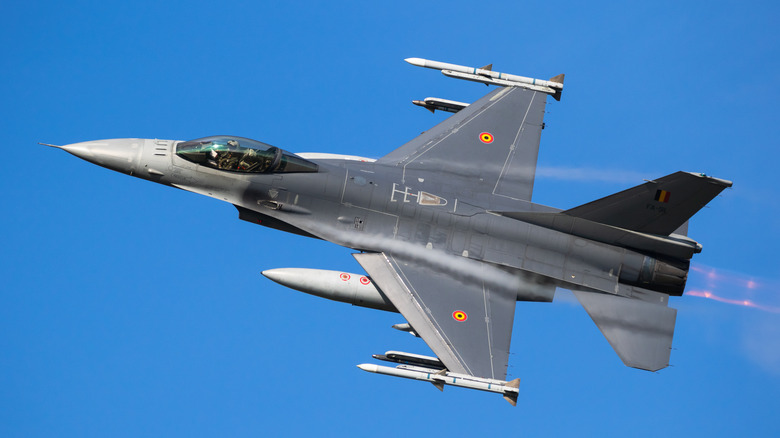How F-16 Fighter Jets Have Evolved Over Nearly 50 Years Of Service
Though icons will always remain icons, that doesn't mean that they don't have to evolve over time. To compete and stay relevant, it's crucial to be able to change and adapt. For celebrities, this often means releasing a timely autobiography if your career's gone a bit quiet. Meanwhile, with technology, frequent upgrades tend to be needed. With military technology, this is especially important.
The F-16 fighter jet is an extraordinary aircraft acclaimed for its versatility. Equipped with a suite of weapons including 2,000-pound bombs and a M-61A1 20-millimeter, it's adept at engaging surface and aerial targets alike, and with a range of more than 2,000 miles and capacity to fly at more than 50,000 feet, it can perform a wide range of roles. Particularly so when considering its sophisticated controls and avionics.
To maintain its versatility, the F-16 has seen a variety of upgrades over its long life to date. Here's when the model was first introduced, and the variants and enhancements have been implemented since. Here's how it's remained relevant in the face of the mighty F-35 and other such aircraft.
The story of the F-16 begins
In 1972, the U.S. military sought a relatively uncomplicated new aerial weapon: A fighter focused on eliminating threats from other aircraft. The perspective plane, it was specified, should also be inexpensive and practical to operate (at least, by the standards of sophisticated Air Force aircraft).
Lockheed Martin (formerly General Dynamics Corporation) would develop the Flying Falcon F-16 in the wake of the Lightweight Fighter project. F-16 designer Harry Hillaker explained to Code One magazine that research around the F-15's time demonstrated that "it was possible to have a fighter that was twice as maneuverable with twice the mission radius of the F-4D Phantom while weighing only 17,050 pounds." Buoyed by the efforts of John Boyd, a fighter pilot who prized the maneuverability of fighters over the likes of raw speed, the project continued, and the F-16 was first fielded in January 1979.
At approximately $14.6 million (fiscal 98 constant), the first F-16s (the F-16A) held true to the promise of being effective, agile, adaptable aircraft that weren't budget-busters. This has largely remained the case throughout the F-16 family's life to date, even though the initial model has been transformed in a variety of ways.
How has the F-16 changed over time?
The F-16 is more than a potent weapon; it's also become a valuable training tool. Some F-16B models boast room for a second crew member, allowing pilots-in-training to gain some first-hand experience while supported by another. The brilliant solution to making the extra space was to reduce the internal space taken up by fuel, thereby not compromising the aircraft's arsenal.
Since the early 1980s, the F-16 family has been equipped with advanced radar and other functionality to help enable it to perform regardless of atmospheric conditions and other factors. This is critical, of course, in an aircraft designed for versatility above all. The Sniper XR and LANTIRN systems also became compatible, and available weaponry has evolved to the Falcon C, and D can equip the AIM-120 AMRAAM.
The aircraft's utility in the United States and beyond has advanced, too. Though it's largely set to be retired in favor of the F-35, it still has its place in the US military's fighter line-up. Indeed, the Block 70/72 model represents a new evolution of the F-16, wielding the likes of a Center Pedestal Display and APG-83 AESA radar (the latter being closely linked to that of the F-35) unlike any the aircraft has boasted before.
Internationally, countries such as Turkey and Belgium have embraced and developed their own F-16 forces, and the FS-X has developed from it. That very versatility and continued updates have been the keys to its long service life.


